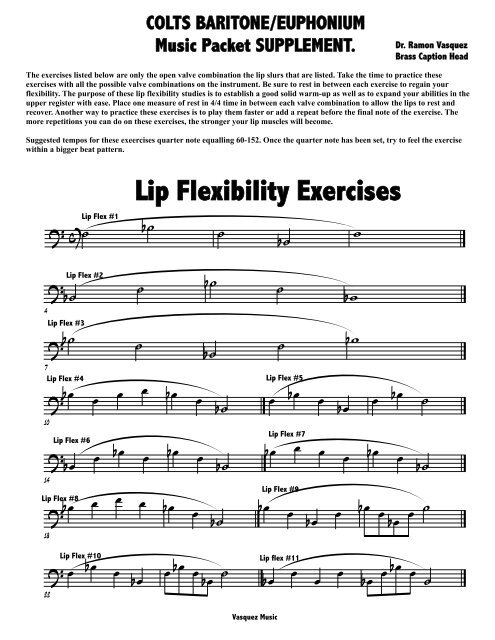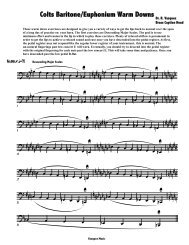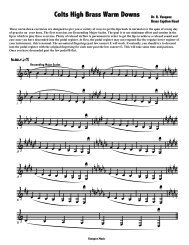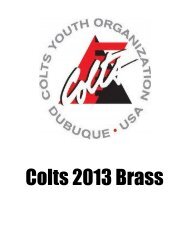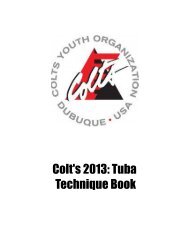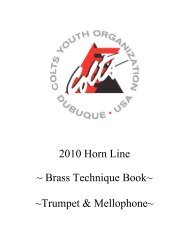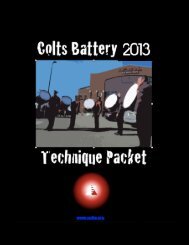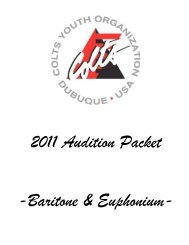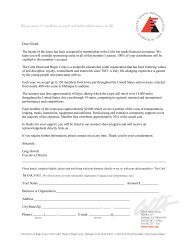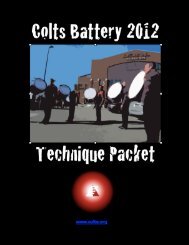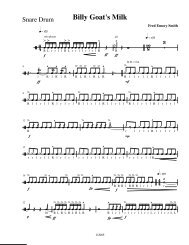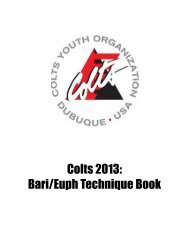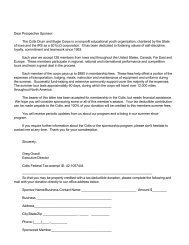COLTS Bari-Euph Warmups.mus
COLTS Bari-Euph Warmups.mus
COLTS Bari-Euph Warmups.mus
Create successful ePaper yourself
Turn your PDF publications into a flip-book with our unique Google optimized e-Paper software.
<strong>COLTS</strong> BARITONE/EUPHONIUMMusic Packet SUPPLEMENT.Dr. Ramon VasquezBrass Caption HeadThe exercises listed below are only the open valve combination the lip slurs that are listed. Take the time to practice theseexercises with all the possible valve combinations on the instrument. Be sure to rest in between each exercise to regain yourflexibility. The purpose of these lip flexibility studies is to establish a good solid warm-up as well as to expand your abilities in theupper register with ease. Place one measure of rest in 4/4 time in between each valve combination to allow the lips to rest andrecover. Another way to practice these exercises is to play them faster or add a repeat before the final note of the exercise. Themore repetitions you can do on these exercises, the stronger your lip <strong>mus</strong>cles will become.Suggested tempos for these exeercises quarter note equalling 60-152. Once the quarter note has been set, try to feel the exercisewithin a bigger beat pattern.Lip Flex #1? c ˙ b˙Lip Flexibility Exercises˙b˙w?b˙Lip Flex #2˙b˙˙bw4Lip Flex #3? b˙˙b˙˙bw7Lip Flex #4? bœœ œ œbœœb˙Lip Flex #5œbœœbœœbœ˙10Lip Flex #6?bœœbœœbœœb˙Lip Flex #7bœœ œ œbœœb˙14? bœœ œ œLip Flex #8bœœb˙Lip Flex #9bœœbœœbœœ bœœ ˙18?œbœLip Flex #10œbœœ bœœ bœ˙Lip flex #11bœœœœbœœ bœœ ˙22Vasquez Music
2 <strong>COLTS</strong> BARITONE/EUPHONIUM Music Packet SUPPLEMENTLip Flex #12? bœœ œ œbœœ œ œ ˙Lip Flex #13œ œ œ œbœ œ œ œbœœ bœœ œ Œ26?Lip Flex #14œ bœœ œœ œœ œœ bœœ bœLip Flex #15œ Œ œ bœœ œ œ œ œ œœ bœœ œ œ Œ30Lip Flex #16? bœœ œ œ œ œ œ œ bœœ œ œ œ Œ34Lip Flex #17bœœ bœœ œœ œ œbœœ bœœ œœ œ œ bœœ bœœ œ œ œ œ bw? bœLip FLex #18œ œ œ œœœ bœbœœ bœœ œ œ œœ bœœ œ œ œ œ bœœ bw40Lip Flex #19?bœœ bœœ œ œ œ œbœœ bœœ œ œ œ œbœœ bœœ œ œ œ œb˙Ó44?Lip Flex #20œ bœœ œbœœ œ œœ bœœ œbœœ œ œ œ bœœ œbœœ œ œ ˙ Ó48Lip Flex #21? bœœ œ bœbœœ œ œbœœ œ bœbœœ œ œ bœœ œ bœbœœ œ œ b˙Ó52
<strong>COLTS</strong> BARITONE/EUPHONIUM Music Packet SUPPLEMENT3The next set of exercises will combine lip flexibility with finger dexterity into one grouping. These will be called LFX (LipFinger Exercises). The concept behind these exercises is to help you break away from the standard, typical lip flexibilityexercises you have played through thus far in your session. These exercises will also challenge you in getting your lips toplay larger intervals that you may not have mastered yet. Notice that all of the patterns will repeat themselves at least once.It would be beneficial to you to practice these exercises faster in order to gain access to larger intervals and further developyour flexibility over larger intervals. The tempo designation from the previous exercises will apply here as well.Once you have gained an understanding of the finger patterns that are on this page, the next step will be to increase yourspeed and accuracy and move on from this starting point. You can also keep this finger/interval pattern and transfer it upone partial within the normal range of the trumpet. The goal is to help in your flexibility. Also try inverting the exercise.Instead of starting in an upwards motion with the flexibility, try moving downwards with the same finger pattern.Lip and Finger ExercisesLFX #1? œ bœœ œ bœbœœ œbœbœœ œ œ œ œ œbœbœnœnœbœbœnœnœœ bœœ œ b˙56LFX #2?œ bœœ œbœbœœ œbœbœœ œ œ œ œ œbœbœnœnœbœbœnœnœœ bœœ œ b˙60LFX #3?œ œ bœœ bœœ bœœbœœbœœ œ œ œ œ bœœ bœœ œ œ bœœ œ bœœ œ b˙6468LFX #4?œ œbœœ bœœ bœœbœœ bœœ œ œ œ œbœœ bœœ œ œ bœœ˙ÓLFX #5? bœœ bœœ bœœ bœœbœœ bœœ bœœ œ œ bœœ bœœ œ œ bœœb˙Ó72LFX #6? bœ# œ# œ nœ# œ œ œ œ# œ œ # œ # œbœœ œ nœ# œ œ œ œ œ œ # œ # œ b˙Ó76
4 <strong>COLTS</strong> BARITONE/EUPHONIUM Music Packet SUPPLEMENTThe following exercises are designed to assist you with your articulations. Now the exercises listed below are suggestedpatterns for performance in which you are to carry these forward to all 12 keys, or notes within a certain scale pattern(either major or minor). With each articulation pattern, strive for a consistent attack of the note as well as a fullness to thesound and duration to the note so as to propel the air forward through the exercise. The goal is to make all the noteswithin these patterns sound even in pitch, sound, tone and length (regardless of subdivision). All notes <strong>mus</strong>t be played fullvalue so as to give the image of a never-ending air supply. The connection from each pitch is done so by the attack of thenext successive pitch, not by cheating the air from the note "of the moment".Practicing these exercises at various tempos and keys will help to further refine your abilities on the horn. As statedpreviously, practice all of these patterns in all keys so as to gain further ability on your horn. If at first you don't succeed,then try try again.Remember: Practice doesn't make Perfect, Practice makes Permanent. Perfect Practice makes Perfect.Suggested tempi to practice the following exercises at is: Quarter Note equals 80-132. Also, Stay focused on the exercisethat you are playing in the moment. Listen to the pitch, attack and duration of each note that you are playing. Of there areinaccuracies in your performance, then take the time to perform them at a slower tempo CORRECTLY.You can also practice these on the mouthpiece as well to further develop your articulation accuracy.Articulation Exercises?80Art. Ex. #1œ œ œ œœ œ œ œ œ œ œ œ œ œ œ œ œ œ œ œ œ œ œ œ œ œ œ œ ˙Ó?Art. Ex. #2œœœœœœœœœŒœœœœ b œœœœœ Œ œ œ œ œ œ œ œ œ œ œ œb œ œ œ œ œ ˙Ó84?Art. Ex. #3œœœœ b œœœœœœœœœœœœœœœœ b œœ œœ œ œœœœœœœ w∑88?bœœ œ œ œ œ œ œ œ œ œ œ œ œ œ œ92Art. Ex. #4bœœ œb œ œ œ œ œ ˙∑
<strong>COLTS</strong> BARITONE/EUPHONIUM Music Packet SUPPLEMENT5The following exercises are designed to help improve the upper register. Although they are not written past a certainpoint, you may elect to play higher than what is written on the page. The goal with performing in the upper register isto attain a solid foundation of sound, airflow and ease as you ascend. The breathing exercises that you have beenexposed to with the Breathing Gym are a valuable resource for you to continue to practice on outside of the monthlycamps. The breath should be full and unlabored at all times. The flow of the air through the body and into the hornshould feel fast and open. If at any point during your practice you feel like you are pushing downwards in anuncomfortable manner, then rest for a while. The sensation you should experience is a firming of the abdomen and aquick release of the air from the lips into the mouthpiece. The object is to play with a full sound (what would sound likea loud sound) with as easy a feeling as possible. Establishing a sound concept is crucial for the success of the exercise.Listen to your favorite trumpet players and try to copy their sound quality whenever possible.One thing to remember is that when you see a measure of rest, take the horn off of the face and exhale. Right before youbegin to play, breathe in quickly, set the lips for the note you are going to play and send the air through the lipWITHOUT holding the air in the body. The breathing should be felt in a cycle. As you breathe in and fill up your lungswith air, release the air quickly through the horn. Do not hold or "Lock" the air in the body before you play. You shouldfeel that as soon as you are full of air, you immediately send the air out of the body in a quick and relaxed manner.Upper Register ExercisesAscending Chromatic Exercise˙?# ˙∑# ˙ ˙∑˙b˙∑b˙n˙∑˙b˙∑95Double Octave Arpeggios?bœœ œ bœ105œ œ b˙bœœ œ bœœ œ b˙Isolated Attack Studyœ œ œ œ?˙Ó# œ œ œ œ # ˙Ó109Asending Perfect Fourth Study˙?˙∑b˙b˙∑˙˙∑113b˙?b˙∑˙˙∑˙b˙∑119
6 <strong>COLTS</strong> BARITONE/EUPHONIUM Music Packet SUPPLEMENTThe purpose behind this fingering chart is to give you an idea of the normal fingerings and some alternate fingers thatcan work once you have reached a certain note in the upper register. Once you have reached a certain place in theupper register, the valves can assist in "Slotting" a note better, but really do not assist in getting the notes to respond.The top number is the normal fingering for the note in question. The fingerings that are below are suggested fingeringsthat can help you "slot" the notes with more ease than the "Normal" fingering.<strong>Bari</strong>tone/<strong>Euph</strong>oniumAltissimo Register Fingering Chart.˙?"F""F-sharp"# ˙"G"˙b˙"A-flat"˙"A""B-flat"b˙12501-32-31-2-311-2311-2-32-321-331-2012-31-2-3?˙"B""C"˙b˙"D-flat""D"n˙"E-flat"b˙n˙"E"1281-221-2-3101-322-31-2-301-231-31 21-2-32-3"F"˙b˙"G-flat""G"˙"A-flat"b˙"A"˙b˙"B-flat"?13101-312-31-2-311-231-311-32-321-32-3012-3
<strong>COLTS</strong> BARITONE/EUPHONIUM Music Packet SUPPLEMENT7Upper Register Exercises continued.The following exercises are extensions of the Upper Register Exercises Already in this packet. The ideas to remember with theseexercises is to maintain a supple set to the lips, a relaxed apeture. The airflow should also remain as relaxed as possible in all registers.The air movement should remain fast and still remember to crescendo through the upper register. The moment you feel any tension in thechest or throat, stop. The feeling we are trying to Establish is one of a relaxed air column that is free from tension.Take a full breath and try blowing a steady stream off of the instrument. Work to make this feeling relaxed and effrortless. Once youhave felt the proper feeling, now add the mouthpiece only. work for this feeling on the mouthpiece. Without producing a sound on themouthpiece, work for a big full breath and try to blow a steady stream of air into the horn with as much freedom as possible. Once youhave achieved this goal, add the mouthpiece to the horn and repeat the process now with the mouthpiece on the horn, but with the lipswrapped around the rim of the mouthpiece. Once you have achieved this feeling, now place the lips inside the mouthpiece as you would toform an embouchure. Repeat the process in the airstream. blow free and easy. Once the feeling has been accomplished, Begin to play theinstrument. Achieve the goal of a steady stream of air and an ease to the sound with very little tension.Double Octave Scales?bœœ œ bœ134œ œ œ bœœ œ bœœ œ œ bU˙ ,bœœ œ œ bœœ?œ bœœ œUœ bœœ œ b˙138Ascending Melodic Exercise? b˙142b˙œ œ œ œ bœb˙˙ ˙.Œ?˙b˙œ bœœ œ bœœ œ bœœ œ b˙.Œ146Ascending Partial Major Scale? bœœ œ bœœbœœ œ b˙Ó150Single Octave Glissando? bœ153bœGlissando~~~~Glissando~~~~˙Double Octave Glissandob˙b˙Glissando~~~~~~~Glissando~~~~~~~b˙Ó


